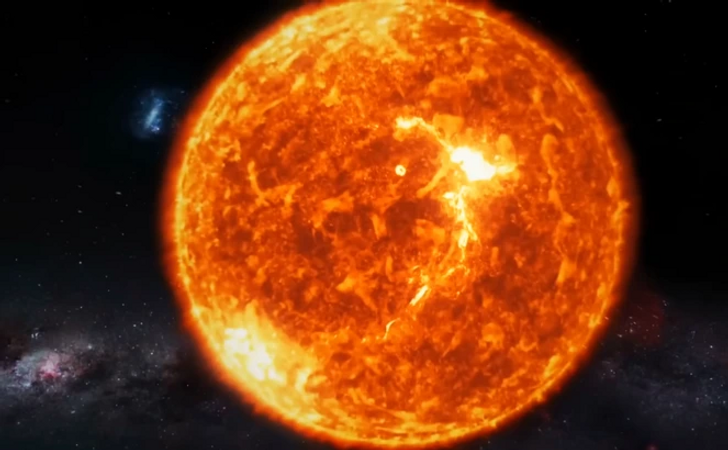Girl’s 10kg (22lbs) Breast Surgery: The Shocking Reality of Gigantomastia

No doubt, our universe is a crazy and mysterious space. Throughout history, humans have been trying to figure it out. While we’ve made progress, every day brings new discoveries that add to our understanding. And what is more fascinating, that when we talk about universe, we mean the whole world we ever knew — from tiny cell in human body to supermassive space objects. After you read these amazing facts about the universe, you might just get super excited too!
While Earth might seem round from space, it’s actually more like an ellipsoid. But even that doesn’t perfectly capture Earth’s shape. The planet’s diameter is larger at the equator because of the centrifugal force from its constant rotation. Mountains that reach nearly 30,000 feet and ocean trenches over 36,000 feet deep distort its shape further. Even sea level isn’t uniform due to slight variations in Earth’s gravity, creating permanent hills and valleys in the ocean of over 300 feet.
Moreover, Earth’s shape is always changing. Daily tides, slow tectonic plate movements, and the rebound of the crust after ice melts contribute to this change. Occasionally, the planet’s shape undergoes rapid, violent shifts during events like earthquakes, volcanic eruptions, or meteor strikes.
The Hubble Space Telescope found that the planet HD 189733b looks deep blue, but it’s not because of oceans. The blue color comes from a really hot atmosphere (2,000 degrees Fahrenheit) where special particles melt and form glass “raindrops” that scatter more blue light than red light.
Discovered in 2005, this planet is super close to its parent star, only 2.9 million miles away. It’s so close that one side always faces the star, and the other side is always in the dark.
Since the planet is just 63 light-years from Earth, someone visiting would see many of the same stars we see at night, although the patterns of constellations would be different. Our Sun and the closest star to it, Alpha Centauri, would look like two faint stars near the center of the image.
Ever notice that when the Moon’s right on the horizon, it looks closer and bigger? It’s called the Ponzo illusion. Your brain tricks you into thinking the Moon is larger than it actually is. Next time try this: block out everything around it with your hands, and you’ll see it shrink before your eyes.
The Ponzo illusion was first demonstrated by the Italian psychologist Mario Ponzo in 1913. He explained that our minds judge an object’s size based on its surroundings. Ponzo illustrated this by drawing two identical lines across a pair of converging lines, resembling railway tracks. Even though the lines were the same length, the upper one appeared longer. This happened because our brains interpreted the converging sides as parallel lines moving into the distance. Seeing the upper line as farther away, we perceived it as longer — following the idea that a more distant object would have to be longer to produce retinal images of the same size.
Our Sun might have had a friend, and there might be many small planets we haven’t found yet in the outer part of our Solar System. Some scientists from Harvard University wrote a paper about this idea. The paper, written by Dr. Avi Loeb and Harvard student Amir Siraj, suggests a different idea than what most people think. They say the Sun might have originally been part of a pair of stars, not just one.
Scientists mentioned that many stars like the Sun are born with a companion. Stars come from clouds of dust and gas in space, and they usually form together in groups before spreading out. This not only happens with the Sun’s “sister” stars, but also with the possible companion, which would be a star of similar size.
So, where is this second Sun now? It could be anywhere in the Milky Way galaxy. According to Loeb, other passing stars in the group where the Sun was born might have pulled the companion away through their gravity.
A groundbreaking study has given us new information about times when North Africa got wetter over the last 800,000 years, making the Sahara Desert green now and then. The study found that these wet periods happened because of changes in how the Earth moves around the Sun, and they didn’t happen as much during the ice ages.
Scientists simulated the past times when the Sahara turned green. They found evidence that the timing and strength of these wet periods were also affected by big, faraway ice sheets in the Northern Hemisphere.
The Sahara Desert turning into grassy areas and woodlands every so often is one of the most interesting changes in the world’s environment.
It has a billion neurons and a quadrillion connections, but we still don’t understand how this amazing organic supercomputer really works. Even though scientists recently studied how the big universe with its galaxies compares to the tiny human brain with its cells.
A fascinating discovery from the study was viewing the brain’s neural network like its own little universe, made up of around 69 billion neurons. Just for comparison, the observable universe consists of a network of at least 100 billion galaxies.
The Moon used to be much closer to Earth, about ten times closer than it is now, making it appear ten times bigger in the night sky. According to computer simulations, it might have been even closer, possibly 12–19 times, at a distance of just 20,000-30,000km, compared to the 384,000km it is today.
The Moon is still moving away. It’s about 3.78cm farther each year due to the transfer of energy from the Earth’s rotation and tidal bulges. This rate is roughly equivalent to the growth of your fingernails.

After some calculations, scientists pointed out that the Sun would theoretically produce a noise of around 100 decibels. Nearly, it is almost as loud as being next to a speaker at a rock concert or busy nightclub. This is quite impressive considering the Sun is 150 million kilometers (over 93,000,000 miles) away from us.
It was explained, the sound waves are so deep that they usually have frequencies that are too low for the human ear to detect. It’s also not a single tone but a highly intricate pattern of acoustical waves, somewhat like a bell.
Human body and Universe have more similarities than we could think. And this is not a consequence. Stars going supernova play a crucial role in forming elements found in the periodic table, including the ones that make up our bodies. As scientists confirm this, stating: “It is totally 100% true: nearly all the elements in the human body were made in a star and many have come through several supernovas.”
Taking into consideration this fact, we can assume that similarities between Universe processes and human body processes are logical. For example, the birth of human body cell look almost the same as star end in the space. As well as human eye look alike galaxy.
Our universe is big and full of secrets, like stars and galaxies, that we’re still trying to understand. Even on our own planet, there are places and things we don’t fully get. Plus, ancient civilizations did cool stuff that we’re still figuring out. It’s like a big adventure of discovery.











